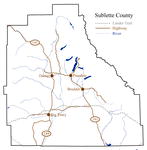|
Sublette Examiner Volume 8, Number 14 - June 26, 2008 brought to you online by Pinedale Online
by Ann Noble The Lander Trail, a cut-off of the Oregon Trail, is celebrating its 150 anniversary of construction this year. The Lander Trail, named for the chief engineer Frederick W. Lander, is 95 miles long as it crossed the southern end of what is now Sublette County from near South Pass to Snyder Basin. Built in 1858, the Lander Trail was the first federally funded road west of the Mississippi River. It was constructed for $40,260 – under budget and on schedule. Wagon trains took three to four days to cross the Green River Valley on the new Lander cut-off. River crossings were popular camping spots. These included the Big Sandy River at what is now called Buckskin Crossing, Grass Springs where the Muddy Speedway now crosses Muddy Creek, the New Fork River near the BLM campground on Highway 351 and the Green River. All of these are now on private land. Emigrants were usually excited to reach the forest after months of traveling open country and would camp at Fort Piney, now Snyder Basin Guard Station, and LaBarge Meadows on LaBarge Creek. The longest waterless section was 10 miles from Sand Springs to the New Fork River. Much of this section is public ground and can be traveled today across what we now call the southern Pinedale Anticline. The Lander cut-off was constructed to improve the condition of the Oregon Trail west of South Pass. The original road moved southward to Green River over one of the most difficult sections. Water and feed for livestockwere scarce due to the dry climate and heavy grazing by large herds of emigrants’ cattle. Nearly 50 miles of this stretch was alkaline desert. The route was entirely unimproved, created through use rather than planned construction. Emigrants had to ascend steep banks, take long detours and struggle through brush and over rocky passes. The Lander cut-off avoided many of these difficult situations, offering more water, better feed and gentler terrain. Travelers complained, though, about the New Fork and Green River crossings. Plans were made to construct bridges for the emigrants using the Lander Trail, but these were not built until the 20th century. In the first full year of use, 1859, an estimated 13,000 emigrants and large herds of livestock used the new Lander Trail. Wagon trains ranged in size from one to 150 wagons. One of Lander’s reports to U.S. Congress indicated that there was an average of 2.9 people and 12.2 head of stock per wagon. The same report indicated that the pioneers came primarily from Illinois, Iowa and Wisconsin with a majority of emigrants bound for California. Except for a slowdown during the Civil War (1860-1865), the Lander Trail was popular with emigrants from its beginning in 1858 until the transcontinental railroad was completed in 1869. Despite the railroad, emigrants continued to travel on the Lander Trail into the 1910s, often coming from the west. It also played a role in the settlement of Sublette County when used to bring cattle and sheep to stock local ranches as well as settlers to the area. Over the past year, Ann Noble on behalf of the Sublette County Historic Preservation Board (SCHPB) and with funding from the Sublette County Commissioners, has surveyed and documented the condition into the 1910s of the trail in Sublette County on private land. Cooperation and support of the landowners has been overwhelming and greatly appreciated. To commemorate the trail sesquicentennial, the SCHPB is sponsoring a series of articles relating to the Lander Trail. See The Archives for past articles. Copyright © 2002-2008 Sublette Examiner All rights reserved. Reproduction by any means must have permission of the Publisher. Sublette Examiner, PO Box 1539, Pinedale, WY 82941 Phone 307-367-3203 examiner@wyoming.com |

